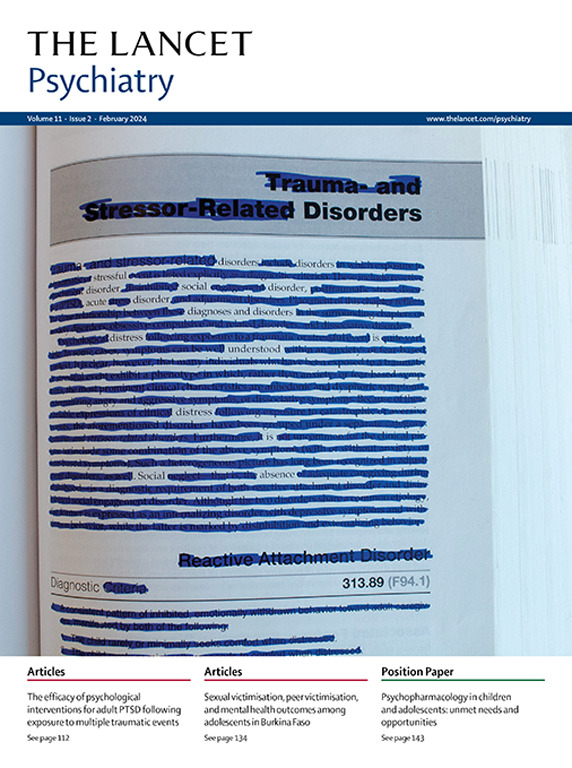Convergent evidence linking neonatal vitamin D status and risk of neurodevelopmental disorders: a Danish case-cohort study
IF 30.8
1区 医学
Q1 PSYCHIATRY
引用次数: 0
Abstract
Background
There is growing evidence linking neonatal vitamin D deficiency to an increased risk of schizophrenia, ADHD, and autism spectrum disorder (ASD). The aim of this study was to examine the association between two vitamin D biomarkers (25 hydroxyvitamin D [25(OH)D] and vitamin D-binding protein [DBP], and their related genetic correlates) and the risk of six mental disorders.Methods
We used a population-based, case-cohort sample of all individuals born in Denmark between 1981 and 2005. Using Danish health registers with follow-up to Dec 31, 2012, we identified individuals diagnosed with major depressive disorder, bipolar disorder, schizophrenia, ADHD, ASD, and anorexia nervosa based on ICD-10 criteria. Additionally, a random subcohort from the general population was selected. Based on neonatal dried blood spots, we measured concentrations of 25(OH)D and DBP. Our primary analyses were based on hazard ratios (HR) with 95% CI and absolute risks for the six mental disorders according to measured concentrations of 25(OH)D and DBP. As secondary analyses, we examined the association between genetic predictors of 25(OH)D and DBP, and the six mental disorders, and Mendelian randomisation analyses based on published summary statistics for 25(OH)D, DBP, and the six mental disorders. People with lived experience contributed to the development of the guiding hypothesis.Findings
We used the total population from the iPSYCH2012 design (n=88 764), which included individuals who developed the six mental disorders, major depressive disorder (n=24 240), bipolar disorder (n=1928), schizophrenia (n=3540), ADHD (n=18 726), ASD (n=16 146), anorexia nervosa (n=3643), and the randomly sampled subcohort (n=30 000). Among those who met a range of inclusion criteria (eg, measured 25[OH]D, DBP or genotype, and predominantly European ancestry), we measured 25(OH)D or DBP in 71 793 individuals (38 118 [53·1%] male and 33 675 [46·9%] female); 65 952 had 25(OH)D and 66 797 the DBP measurements. Significant inverse relationships were found between 25(OH)D and schizophrenia (HR 0·82, 95% CI 0·78–0·86), ASD (HR 0·93, 95% CI 0·90–0·96), and ADHD (HR 0·89, 95% CI 0·86–0·92). A significant inverse relationship was found between DBP and schizophrenia (HR 0·84, 95% CI 0·80–0·88). Based on polygenic risk scores, higher concentrations of 25(OH)D (adjusted for DBP) were significantly associated with a reduced risk of both ASD and schizophrenia. Analyses based on Mendelian randomisation provided support for a causal association between both lower 25(OH)D and DBP concentrations and an increased risk of ADHD.Interpretation
Convergent evidence finds that neonatal vitamin D status is associated with an altered risk of mental disorders. Our study supports the hypothesis that optimising neonatal vitamin D status might reduce the incidence of a range of neurodevelopmental disorders.Funding
The Danish National Research Foundation.新生儿维生素D状况与神经发育障碍风险相关的综合证据:丹麦病例队列研究
背景越来越多的证据表明新生儿维生素D缺乏与精神分裂症、多动症和自闭症谱系障碍(ASD)的风险增加有关。本研究的目的是研究两种维生素D生物标志物(25羟基维生素D [25(OH)D]和维生素D结合蛋白[DBP]及其相关遗传相关因子)与六种精神障碍风险之间的关系。方法:我们采用基于人群的病例队列样本,包括1981年至2005年间出生在丹麦的所有个体。通过丹麦健康登记,随访至2012年12月31日,我们根据ICD-10标准确定了被诊断为重度抑郁症、双相情感障碍、精神分裂症、ADHD、ASD和神经性厌食症的个体。此外,从一般人群中随机选择一个亚队列。根据新生儿干血斑,我们测量了25(OH)D和DBP的浓度。我们的主要分析基于风险比(HR), 95% CI和根据测量的25(OH)D和DBP浓度的六种精神障碍的绝对风险。作为次要分析,我们研究了25(OH)D和DBP的遗传预测因子与六种精神障碍之间的关联,并基于已发表的25(OH)D、DBP和六种精神障碍的汇总统计数据进行了孟德尔随机化分析。有实际经验的人对指导性假说的发展做出了贡献。研究结果:我们使用iPSYCH2012设计的总人群(n=88 764),其中包括患有六种精神障碍的个体,重度抑郁症(n=24 240)、双相情感障碍(n=1928)、精神分裂症(n=3540)、多动症(n=18 726)、自闭症(n=16 146)、神经性厌食症(n=3643),以及随机抽样的亚队列(n=30 000)。在符合一系列纳入标准(例如,测量25[OH]D, DBP或基因型,主要是欧洲血统)的人中,我们测量了71 793人的25(OH)D或DBP(38 118人[53.1%]男性和33 675人[46·9%]女性);65 952例有25(OH)D, 66 797例有DBP。25(OH)D与精神分裂症(HR 0.82, 95% CI 0.78 ~ 0.86)、ASD (HR 0.93, 95% CI 0.90 ~ 0.96)、ADHD (HR 0.89, 95% CI 0.86 ~ 0.92)呈显著负相关。DBP与精神分裂症呈显著负相关(HR 0.84, 95% CI 0.80 - 0.88)。根据多基因风险评分,较高浓度的25(OH)D(经DBP调整)与ASD和精神分裂症的风险降低显著相关。基于孟德尔随机化的分析支持了25(OH)D和DBP浓度较低与ADHD风险增加之间的因果关系。越来越多的证据表明,新生儿维生素D水平与精神障碍风险的改变有关。我们的研究支持了一个假设,即优化新生儿维生素D水平可能会减少一系列神经发育障碍的发病率。丹麦国家研究基金会。
本文章由计算机程序翻译,如有差异,请以英文原文为准。
求助全文
约1分钟内获得全文
求助全文
来源期刊

Lancet Psychiatry
PSYCHIATRY-
CiteScore
58.30
自引率
0.90%
发文量
0
期刊介绍:
The Lancet Psychiatry is a globally renowned and trusted resource for groundbreaking research in the field of psychiatry. We specialize in publishing original studies that contribute to transforming and shedding light on important aspects of psychiatric practice. Our comprehensive coverage extends to diverse topics including psychopharmacology, psychotherapy, and psychosocial approaches that address psychiatric disorders throughout the lifespan. We aim to channel innovative treatments and examine the biological research that forms the foundation of such advancements. Our journal also explores novel service delivery methods and promotes fresh perspectives on mental illness, emphasizing the significant contributions of social psychiatry.
 求助内容:
求助内容: 应助结果提醒方式:
应助结果提醒方式:


